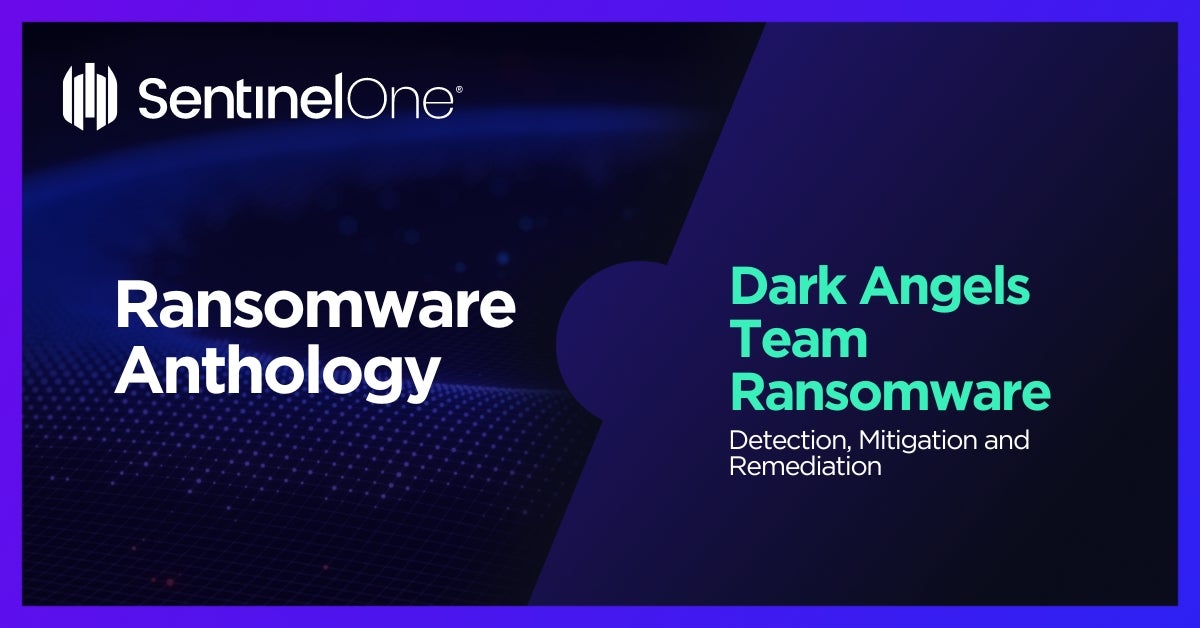Dark Angels Team Ransomware: In-Depth Analysis, Detection, and Mitigation
Dark Angels Team emerged in May 2022. Actors behind Dark Angels Team campaigns practice double extortion – demanding payment for a decryptor, as well as for the non-release of stolen data. The code for Dark Angels Team’s Windows-focused payloads is derived from the leaked Babuk builders and is nearly identical feature-wise. In late 2023, Linux/ESXi-focused payloads were discovered. These non-Windows variants of Dark Angels Team ransomware are not derived from Babuk, instead opting for a more bespoke codebase akin to RagnarLocker.

What Does Dark Angels Team Ransomware Target?
Dark Angels Team ransomware has been found to target a variety of industries including healthcare, government, finance, and education. In September 2023, automation and manufacturing company Johnson Controls was targeted in a ransomware attack where threat actors used DarkAngels ransomware to lock the company’s VMWare ESXi servers.

How Does Dark Angels Team Ransomware Work?
Dark Angel Team’s Windows payloads are based on the source code of Babuk, and function in very much the same way. The ransomware will attempt to inhibit system recovery and terminate any process that may interfere with the encryption process.
Linux/ESXi-focused payloads from Dark Angels Team are based on a different codebase, and therefore differ greatly from their Windows counterparts. Dark Angels Team payloads on Linux/ESXi are 64-bit Executable & Linkable Format (ELF) binaries designed for Intel-based Linux systems. On execution, the program logs the encryption progress to the hardcoded log file name, wrkman.log, which is saved to the directory that the DarkAngels binary is run from. DarkAngels (Linux) uses AES with a 256-bit key to encrypt files.
Dark Angels Team (Linux) takes optional arguments, which are documented internally as dl:m:s:v.
| Argument | Function |
| -m | Allows the operator specify how many encryption threads to run concurrently, which can be 10, 20, 25, 33, or 50 |
| -v | Enables verbose logging mode to the command line |
| -l | Allows the operator to specify a log file name for the progress log |
Dark Angel Team Ransomware (on Windows) will accept either the ‘paths’ or ‘shares’ arguments to enable network discovery and enumeration. Different methods and APIs are used depending on which argument is passed to the ransomware payload executable.
Dark Angel Team attacks are very specific, with target names appearing in the samples and related ransom notes. In the Windows version, the ransomware has the ability to spread to adjacent hosts. When spreading over the network, the payload processes each machine in serial, one after the other, making the encryption process across the network less efficient and more time consuming.
How to Detect Dark Angels Team Ransomware
The SentinelOne Singularity XDR Platform can identify and stop any malicious activities and items related to Dark Angels Team ransomware.
In case you do not have SentinelOne deployed, detecting Dark Angels Team ransomware requires a combination of technical and operational measures designed to identify and flag suspicious activity on the network. This allows the organization to take appropriate action, and to prevent or mitigate the impact of the ransomware attack.
To detect Dark Angels Team ransomware without SentinelOne deployed, it is important to take a multi-layered approach, which includes the following steps:
- Use anti-malware software or other security tools capable of detecting and blocking known ransomware variants. These tools may use signatures, heuristics, or machine learning algorithms, to identify and block suspicious files or activities.
- Monitor network traffic and look for indicators of compromise, such as unusual network traffic patterns or communication with known command-and-control servers.
- Conduct regular security audits and assessments to identify network and system vulnerabilities and ensure that all security controls are in place and functioning properly.
- Educate and train employees on cybersecurity best practices, including identifying and reporting suspicious emails or other threats.
- Implement a robust backup and recovery plan to ensure that the organization has a copy of its data and can restore it in case of an attack.
How to Mitigate Dark Angels Team Ransomware
The SentinelOne Singularity XDR Platform can return systems to their original state using either the Quarantine or Repair.
In case you do not have SentinelOne deployed, there are several steps that organizations can take to mitigate the risk of Dark Angels Team ransomware attacks:
Educate employees: Employees should be educated on the risks of ransomware, and on how to identify and avoid phishing emails, malicious attachments, and other threats. They should be encouraged to report suspicious emails or attachments, and to avoid opening them, or clicking on links or buttons in them.
Implement strong passwords: Organizations should implement strong, unique passwords for all user accounts, and should regularly update and rotate these passwords. Passwords should be at least 8 characters long, and should include a combination of uppercase and lowercase letters, numbers, and special characters.
Enable multi-factor authentication: Organizations should enable multi-factor authentication (MFA) for all user accounts, to provide an additional layer of security. This can be done through the use of mobile apps, such as Google Authenticator or Microsoft Authenticator, or through the use of physical tokens or smart cards.
Update and patch systems: Organizations should regularly update and patch their systems, to fix any known vulnerabilities, and to prevent attackers from exploiting them. This includes updating the operating system, applications, and firmware on all devices, as well as disabling any unnecessary or unused services or protocols.
Implement backup and disaster recovery: Organizations should implement regular backup and disaster recovery (BDR) processes, to ensure that they can recover from ransomware attacks, or other disasters. This includes creating regular backups of all data and systems, and storing these backups in a secure, offsite location. The backups should be tested regularly, to ensure that they are working, and that they can be restored quickly and easily.